Overview
Within This Page
Buildings in any geographic location are subject to a wide variety of natural phenomena such as windstorms, floods, earthquakes, and other hazards. While the occurrence of these incidents cannot be precisely predicted, their impacts are well understood and can be managed effectively through a comprehensive program of hazard mitigation planning.
Ongoing changes in climate patterns around the world may alter the behavior of hydrometeorological phenomena within our lifetimes. The frequency and severity of floods, storms, droughts, and other weather-related disasters is expected to increase, as is the risk from associated changes in the manifestation of other hazards such as wildland fires.
Only after the overall risk is fully understood should mitigation measures be identified, prioritized, and implemented. Basic principles underlying this process include:
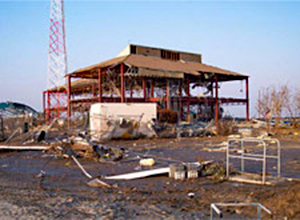
Gulfport, Mississippi after Hurricane Katrina
-
Hazard mitigation is at the core of disaster resistance and supports achieving resilience. Presidential Policy Directive (PPD) 8 (PPD-8 2011) defines resilience as "the ability to adapt to changing conditions and withstand and rapidly recover from disruption due to emergencies. PPD-21 (2013) expanded the definition to include "the ability to prepare for and adapt to changing conditions and to withstand and recover rapidly from disruptions. (NIST Special Publication 1190: Community Resilience Planning Guide for Buildings and Infrastructure Systems, Volume 1, p. 2) Mitigation is an essential part of ensuring continuity of businesses, schools, government facilities, utilities, and communities following hazard events.
-
Unsustainable development also is one of the major factors in the rising costs of natural disasters. Many mitigation design strategies and technologies serve double duty, by not only preventing or reducing disaster losses but serving the broader goal of long-term community sustainability. For example, land use regulations prohibiting development in flood-prone areas may also help preserve the natural and beneficial functions of floodplains.
-
Mitigation serves to attenuate the cascading effects where hazard events degrade an asset, or community of assets, followed by such degradations propagating throughout the asset, or community of assets. During this propagation of degradations, additional hazards might be created, thus further increasing the rate and magnitude of functional degradations of assets.
-
Unanticipated interactions from concurrent or sequential multi-hazard events (dependent or independent; natural, man-made or accidental) may result in a compounded impact with cascading effects and previously unconsidered consequences. Such consequences may be further amplified by outside factors such as poor maintenance of assets, or failure to increase infrastructure capacity with rising demand. Failure to follow an interdependent multi-hazard resilience strategy considering cascading effects may result in unanticipated and costly consequences from an asset-based perspective, and from corresponding effects projected into the community.
-
The impacts of natural hazards and the costs of the disasters they cause will be reduced whether mitigation measures are implemented during new construction (preventively) or as retrofits (correctively). Proactively integrating mitigation measures into new construction is typically more economically feasible than retrofitting existing structures.
-
Risk reduction techniques must address as many applicable hazards as possible. This approach, known as all-hazard mitigation, is the most Cost-Effective approach, maximizes the protective effect of complementary mitigation measures and optimizes all-hazard design techniques with other building technologies.
-
High-performance buildings should be designed to adopt strategies that exceed model building code requirements for disaster resistance.
Recommendations
Design professionals agree that the most successful way to mitigate losses of life, property, and function is to design buildings that are disaster-resistant. This approach should be incorporated into the project planning, design, and development at the earliest possible stage so that design and material decisions can be based on an integrated "whole building approach."
A variety of techniques are available to mitigate the effects of natural hazards on the built environment. Depending on the hazards identified, the location and construction type of a proposed building or facility, and the specific performance requirements for the building, the structure can be designed to resist hazard effects such as induced loads. Later in the building's life cycle, additional opportunities to further reduce the risk from natural hazards may exist when renovation projects and repairs of the existing structure are undertaken. When incorporating disaster reduction measures into building design, some or all of the issues outlined below should be considered in order to protect lives, properties, and operations from damages caused by natural hazards.
Earthquakes
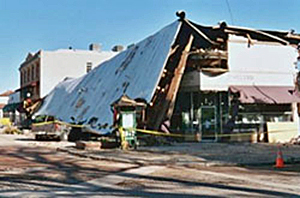
Earthquake Damage - Paso Robles, California
FEMA News Photo
Building design will often be influenced by the level of seismic resistance desired. This level can range from prevention of nonstructural damage in occasional moderate ground shaking to prevention of structural damage and minimization of nonstructural damage in occasional moderate ground shaking, and even avoidance of collapse or serious damage in rare major ground shaking. Seismic resistance for stronger events also can support higher numbers of occupiable buildings post disaster. These performance objectives can be accomplished through a variety of structural engineering measures or structural components like shear walls, braced frames, moment resisting frames, and diaphragms, base isolation, energy dissipating devices such as visco-elastic dampers, elastomeric dampers, and hysteretic-loop dampers, and bracing of nonstructural components. Simpler techniques also are available including avoiding soft stories and bolting the sill plate of houses to the foundation. Note that the primary focus of earthquake design is initial life safety and getting people out of the building safely, not necessarily the ability of a building to withstand the effects of an earthquake, or to ensure occupancy or functionality following an event. Seismic design of DoD projects requires mandatory compliance with UFC 3-310-04 and IBC chapter 16, the International Existing Buidling Code (IEBC) and ASCE 7 for other federal agencies and private sector buildings.
Hurricanes, Typhoons, and Tornadoes
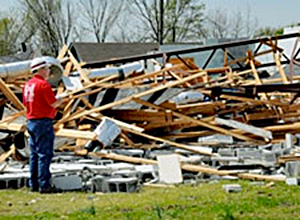
Tornado Damage - Mena, Arkansas
FEMA News Photo
The key strategy for protecting a building from damage caused by tornados under F2, hurricanes, and gust fronts is to maintain the integrity of the building envelope, including roofs and windows, and to design the structure to withstand the expected lateral and uplift forces. For example, roof trusses and gables must be braced; hurricane straps must be used to strengthen the connection between the roof and walls and walls and foundation; and doors and windows should be protected by covering and/or bracing. The load path and connectors are just as important as bracing. When planning renovation projects, designers should consider opportunities to upgrade the roof structure and covering, and enhance the protection of openings by considering the addition of impact-resistant windows, doors, louvers, etc. In addition to protection of the structure, life safety is a key goal of design or upgrades to protect from wind damage. The ability to "shelter-in-place" within an otherwise deficient structure can meet this goal. These areas can be constructed to protect a large number of people from a natural hazard incident for occupant refuge during catastrophic windstorms. The Additional Resources section of this page includes several FEMA publications for designing community shelters. The key strategy is mandatory compliance with UFC 3-301-01 and IBC chapter 16 for DOD and ASCE 7 for other federal agencies and private sector buildings.
Flooding
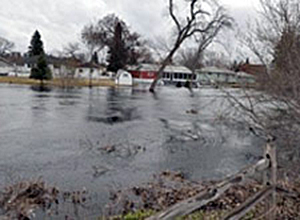
Flooding in North Dakota
FEMA News Photo
Flood mitigation is best achieved by hazard avoidance—that is, risk-informed site selection away from coastal, estuarine, and riverine floodplains. Still flooding and velocity flooding present hazards.
- Riverine hazards are associated with flooding from stream networks.
- Coastal hazards are associated with flooding from oceans or lakes and sea level rise related to climate change.
- Still-water events are characterized by rising water with no horizontal movement.
- Velocity events are characterized by fast moving waters at any depth.
When buildings must be sited in flood-prone locations, they should be elevated above expected flood levels for at least the design return period to reduce the chances of flooding and to limit the potential damage to the building and its contents when it is flooded. Other flood mitigation techniques include; dry flood-proofing, or making the building watertight to prevent water entry; wet flood-proofing, or making uninhabited or non-critical parts of the building resistant to water damage; relocation of the building; and the incorporation of floodwalls into site design to keep water away from the building. Note that levees require a significant amount of care and are discouraged as a mitigation measure. American Society of Civil Engineers ASCE7-16 has a new chapter on tsunami loads and effects.
Rainfall, Wind-Driven Rain, and Ice Dams
One of the primary performance requirements for any residential building and most commercial buildings is that it should keep the interior space dry. All roofs and walls must therefore shed rainwater, and resist water penetration. For example, roof drainage design must minimize the possibility of ponding water, and existing buildings with flat roofs must be inspected to determine compliance with this requirement. Pitched roofs in cold climates need to be designed to prevent ice dams. Recommendations for addressing rainfall and wind-driven rain can be found in the International Building Code (IBC) series.
Differential Settlement (Subsidence)
Ground subsidence can result from mining, sinkholes, underground fluid withdrawal, hydrocompaction, and organic soil drainage and oxidation. Subsidence mitigation can best be achieved through careful site selection, including geotechnical study of the site. In subsidence-prone areas, foundations must be appropriately constructed, and utility lines and connections must be stress-resistant. When retrofitting structures to be more subsidence-resistant, shear walls, geo-fabrics, and earth reinforcement techniques such as dynamic compaction can be used to increase resistance to subsidence damage and to stabilize collapsible soils.
Landslides and Mudslides
Gravity-driven movement of earth material can result from water saturation, slope modifications, rainfall occurring after wildfire, and earthquakes. Techniques for reducing landslide and mudslide risks to structures include selecting non-hillside or stable slope sites; constructing channels, drainage systems, retention structures, and deflection walls; planting groundcover; and soil reinforcement using geo-synthetic materials, and avoiding cut and fill building sites. Design for the direct effects of a landslide is not cost-effective.
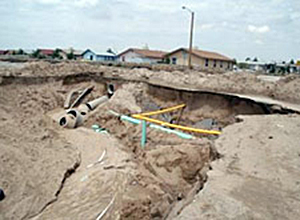
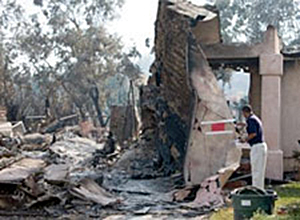
Mudslide - El Paso, Texas
FEMA News Photo
Wildfire - Rancho Bernardo, California
FEMA News Photo
Wild Land Fire / Urban Interface
As residential developments expand into wild land areas, people and property are increasingly at risk from wild land fire. Fire is a natural process in any wild land area and serves an important ecological and regenerative purpose; however, if ground cover is burned away, erosion, landslide, mudflow, and flood hazards can be exacerbated. A cleared safety zone should be maintained between structures and combustible vegetation, and fire-resistant ground cover, shrubs, and trees should be used for landscaping (for example, hardwood trees are less flammable than pines, evergreens, eucalyptus or firs). Only fire-resistant or non-combustible materials should be used on roofs and exterior surfaces. Roofs and gutters should be regularly cleaned and chimneys should be equipped with spark arrestors. Vents, louvers, and other openings should be covered with wire mesh to prevent embers and flaming debris from entering. Overhangs, porches, and balconies can trap heat and burning embers and should also be avoided or minimized and protected with wire mesh. Windows allow radiated heat to pass through and ignite combustible materials inside, but dual- or triple-pane thermal glass, fire-resistant shutters or drapes, and noncombustible awnings can help reduce this risk.
Tsunami
A tsunami is a series of ocean waves generated by sudden displacements in the sea floor, landslides, or volcanic activity. In the deep ocean, the tsunami wave may only be a few inches high. The tsunami wave may come gently ashore or may increase in height to become a fast moving wall of turbulent water several meters high. Although a tsunami cannot be prevented, the impact of a tsunami can be mitigated through urban/land planning, siting away from shorelines, community preparedness, timely warnings, and effective response. For resistance in buildings ASCE7-16 will include a new chapter on tsunami loads and effects.
Related Issues
Areas of Refuge
An area of refuge is a location designed to protect facility occupants during an emergency, when evacuation may not be safe or possible due to area contamination, obstruction, or other hazard natural or manmade. Occupants can wait there until given further instructions or rescued by first responders. Areas of refuge can be safe havens, shelters, secure rooms, or protected spaces, each intended for protection from specified hazards and for different durations of occupancy. Safe Havens and shelters generally provide protection for a relatively short duration, of hours, not days or weeks. A secure room is generally constructed to meet specified hardening criteria based on the design hazard. Protected areas are readily available locations that afford safety to people by their shielding characteristics, such as a firewall. Areas of refuge may be freestanding or integrated in a building.
Planning, rehearsal, and preparatory procedures (routine maintenance/testing of equipment, checking shelf life of stored provisions and materials) are paramount to a successful area of refuge. Well-written standing operating procedures (SOP) should outline who makes decisions, when and how to evacuate, responsibilities and operating procedures, and when and how to leave the area of refuge. Depending on the function, planning may include, but is not limited to, personnel accountability protocol, communications for notification and instructions (transmitters/receivers, megaphones, whistles), comfort provisions such as seating and bedding, life-support systems such as fire apparatus, dedicated ventilation/filtration, plumbing, emergency power/fuel supply, lighting (including emergency lighting), decontamination, and maintenance. In addition to storage provisions of food, water, and first-aid, other items/supplies may include: current emergency contact numbers, dust masks, flashlights, vests or other identification/apparel, wind-up or battery-operated radios, toiletries, stationary for emergency administration (assignments, name/billet labels, instructions, etc.), an audible sounding device that continuously charges or operates without a power source (e.g., canned air horn) to signal rescue workers if refuge egress is blocked, tools and maintenance manuals.
Key design considerations include reaction time (travel distance to refuge and activation time for emergency support systems), duration of occupancy, privacy, security (secure storage, doors, locks, windows/view ports), isolation areas for ill or contaminated occupants/equipment, and hardening criteria to mitigate specified threats. The refuge size is based on the maximum intended occupancy. The location should be readily accessible to all people who are to be protected. Travel time is especially important when refuge users have disabilities that impair their mobility and may need assistance from others to reach the refuge. Alternate accessible routes should be considered for use in the event that the primary route is blocked or inoperable. If the refuge is integrated into a building, a centrally located, interior room/space is preferable. If the refuge has windows, they should be capable of being sealed. Stand-alone refuges should be sited away from potential hazards, such as debris, excessive glazing, flooding or storm surge, power lines, or nearby structures that may be toppled or become airborne. In some situations, multiple small shelters may best suit the situation rather than one large shelter. The location should not be selected based on height above ground level if it would increase the travel time to the refuge. Signage and warning signals are critical for users to know when and where to seek refuge. Critical support systems located outside of the area of refuge area should be afforded the same protection criteria as the refuge.
During an emergency, preparatory actions may be required by designated team members outside the area of refuge, such as the turning off of fans, air-conditioning, or forced heat systems, the closing of windows or blinds, and the shutting of doors (securing doors in a lock-down situation). To close all doors quickly in a large building, there must be a notification system such as a public address system. Also, occupant furniture may have to be relocated to allow the maximum number of occupants in the room or building.
Critical Infrastructure
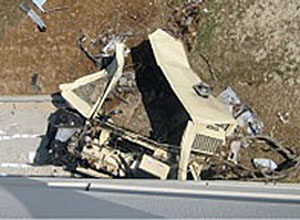
Emergency backup generator destroyed by storm surge during Hurricane Katrina
Photo courtesy of Applied Research Associates, Inc.
-
In providing the desired level of natural hazard protection and resilience within the constructed environment, stand-alone and integrated critical infrastructure systems serve a vital role. Such systems require appropriate levels of redundancy, as well as positioning, hardening, and protection of critical elements for each system to enhance their survivability, while facilitating access for post-event functionality, maintenance and repair. Critical elements include resources needed to achieve the desired level of survivability and post-event performance (power, water, communications, personnel, transportation, supplies/materials, etc.). These should be identified and prioritized, with evaluation of consequence of loss for each critical resource during a multi-hazard event. In evaluating required critical infrastructure needs, a balance must be struck between on-site (stand-alone) resilience, and off-site (community-based) resilience needed to support survivability and post-event response and recovery for each building.
-
Within the building, design and positioning of critical infrastructure and backup systems should consider protection from identified multi-hazard events, with a goal of maintaining post-event operability or rapid restoration based on facility function and requirements. Stand-alone backup systems and redundant utility feeds within the facility, such as power, water, communications, gas, etc., should be provided as needed to meet the intent for achieving facility resilience. Design measures should also include appropriate anchorage and attachment of critical infrastructure systems for multi-hazard events that may impact the facility.
-
External to the building, all exterior backup systems should be protected from direct exposure to a multi-hazard event. Utility backup access points at the building envelope, avenues of approach to these access points, and corresponding equipment setup locations for rapid post event restoration of critical utilities should be provided. Such access points will also provide for advance-positioning of additional emergency backup equipment for added capacity, should outages exceed the limits of current in-place backup systems. These backup provisions should be pre-coordinated with outside response agencies as appropriate, with specific access points and types of services documented.
Beyond the building site, redundant utility feeds available to serve the building site (power, water, communications, gas, etc.) should be utilized as available. The multi-hazard resilience of the surrounding community should be evaluated, particularly with regard to community-based critical infrastructure such as public and private utilities and transportation. Even if stand-alone backup systems are present at the building level, prolonged disruptions within the surrounding communities may impact building resilience from a response and recovery perspective.
Federal Guidelines for Dam Safety. The Interagency Committee on Dam Safety (ICODS) has prepared and approved these federal guidelines for federal agency dam owners and regulators.
Relevant Codes and Standards
Regulations, codes, standards, and best practices guide the design of buildings to resist natural hazards. For new buildings, code requirements serve to define the minimum mitigation requirements for life safety and serviceability, but compliance with regulations in building design is not always sufficient to guarantee that a facility will perform adequately when impacted by the forces for which it was designed. Indeed, individual evaluation of the costs and benefits of specific hazard mitigation alternatives can lead to effective strategies that will exceed the minimum requirements. Additionally, special mitigation requirements may be imposed on projects in response to locale-specific hazards. When a change in use or occupancy occurs, the designer must determine whether this change triggers other mitigation requirements and must understand how to evaluate alternatives for meeting those requirements.
Finally, designers should augment the codes and standards to consider the importance of nonstructural elements, assets, and mission of the building, i.e., windows, hoods, parapets and balcony railings, and electrical and mechanical systems, because they may account for more than 70% of the value of a building.
- ACI 318: Building Code Requirements for Structural Concrete and Commentary
- ICC IBC International Building Code
- ASCE/SEI 7 Minimum Design Loads for Buildings and Other Structures, includes model requirements for dead, live, soil, flood, wind, snow, rain, ice, and earthquake loads, and their combinations, that are suitable for inclusion in building codes
- NFPA 1: Fire Code, National Fire Protection Association
Many states and municipalities have also adopted supplemental codes to meet local requirements for all-hazard protection. Examples of such codes include:
- California Building Code, Title 24
- Miami-Dade County Code
- Structural Engineers Association of California (SEAOC)
General All-Hazards
- Public Law 106–390, Disaster Mitigation Act of 2000
Earthquake
- Executive Order 13717, "Establishing a Federal Earthquake Risk Management Standard" (February 5, 2016)
- Public Law 95–124, Earthquake Hazards Reduction Act (1977) 42 U.S. Code Chapter 86, Earthquake Hazards Reduction
- Public Law 101–614: National Earthquake Hazards Reduction Program Reauthorization Act (1990)
- Public Law 103–374: Earthquake Hazards Reduction Act Of 1977, Authorization and Amendment (1994)
- Public Law 106–503: Earthquake Hazards Reduction Authorization Act (2000)
- UFC 3-301-01 Structural Engineering
- UFC 3-310-04 Seismic Design for Buildings
Hurricane, Typhoon, and Tornado
Flood
- Executive Order 11988, "Floodplain Management"
- Public Law 93–234: National Flood Insurance Act (1968)
Tsunami
Rainfall and Wind-Driven Rain
- National Institute of Standards and Technology
- U.S. Department of Defense
- U.S. Department of Energy
Additional Resources
Organizations and Associations
General All-Hazards
- American Planning Association—Growing Smart
- American Society of Civil Engineers (ASCE)
- Applied Technology Council (ATC) — A nonprofit organization dedicated to developing and promoting state-of-the-art, user-friendly engineering resources and applications for use in mitigating the effects of natural and other hazards on the built environment
- Federal Alliance for Safe Homes (FLASH)
- Federal Emergency Management Agency (FEMA) Mitigation Information
- Insurance Institute for Business & Home Safety (IBHS)
- Multihazard Mitigation Council (MMC) — A program of the National Institute of Building Sciences (NIBS)
- National Hazard Mitigation Association (NHMA)
- National Institute of Standards and Technology (NIST)
- National Oceanic and Atmospheric Administration (NOAA)
- University of Colorado, Boulder — Natural Hazards Center
- U.S. Geological Survey (USGS) — For Flood and Seismic Mapping
- U.S. Resiliency Council (USRC)
Disaster Management
- Department of Homeland Security, Science & Technology, Homeland Security Advanced Research Projects Agency (HSARPA)
- National Emergency Management Association (NEMA)
Earthquake
- Building Seismic Safety Council (BSSC) — Established by the National Institute of Building Sciences (NIBS) to develop and promote building earthquake risk mitigation regulatory provisions for the nation
- Consortium of Universities for Research in Earthquake Engineering (CUREE)
- Earthquake Engineering Research Institute (EERI)
- FEMA Hazus-MH (Hazards US-Multi Hazard earthquake model)
- Pacific Earthquake Engineering Research Center (PEER)
- Structural Engineers Association of California (SEAOC)
Hurricane, Typhoon, and Tornado
- National Roofing Contractors Association (NRCA)
- National Glass Association with GANA
- Texas Tech University — National Wind Institute (NWI)
- Wind Load Test Facility (WLTF) at Clemson University
Flood
- Association of State Floodplain Managers (ASFPM)
- FEMA National Flood Insurance Program
- National Geospatial-Intelligence Agency (NGA)
Forest Fires
- California Fire Safe Council (CFSC)
- Department of Homeland Security — Wildfires
- NFPA Firewise Communities Program
- National Interagency Fire Center (NIFC)
- Utah Fire Information
Publications
General All-Hazards
- Disasters by Design: A Reassessment of Natural Hazards in the United States. Mileti, Dennis S. Washington, DC: John Henry Press, 1999.
- Federal Emergency Management Agency
- Building Science
- Mitigation Best Practices
- Mitigation Assessment Team (MAT) Program
- FEMA 364 Planning for a Sustainable Future: The Link Between Hazard Mitigation and Livability
- FEMA 421 Planning for Post-Disaster Recovery and Reconstruction
- FEMA 424 Design Guide for Improving School Safety in Earthquakes, Floods and High Winds
- FEMA 365 Rebuilding for a More Sustainable Future: An Operational Framework
- FEMA 386-2 Understanding Your Risks: Identifying Hazards and Estimating Losses
- ICC 500 Standard for the Design and Construction of Storm Shelters
- Regional Disaster Resilience: A Guide for Developing an Action Plan , 2011 Edition. The Infrastructure Security Partnership (TISP)
Earthquake
- Federal Emergency Management Agency—FEMA Earthquake Publications
- FEMA P-749 Earthquake-Resistant Design Concepts: An Introduction to the NEHRP Recommended Seismic Provisions for New Buildings and Other Structures
- FEMA E-74 Reducing the Risks of Nonstructural Earthquake Damage—A Practical Guide, Fourth Edition
- FEMA 83 Seismic Considerations for Communities at Risk
- FEMA P-154 Rapid Visual Screening of Buildings for Potential Seismic Hazards: A Handbook, Third Edition
- FEMA 156 Typical Costs for Seismic Rehabilitation of Existing Buildings Volume 1: Summary. Second Edition
- FEMA 157 Typical Costs for Seismic Rehabilitation of Existing Buildings Volume 2: Supporting Documentation. Second Edition
- FEMA 173 and FEMA 174: Establishing Programs and Priorities for the Seismic Rehabilitation of Buildings: Supporting Report and Handbook
- FEMA 198 Financial Incentives for Seismic Rehabilitation of Hazardous Buildings – An Agenda for Action. Volume 1: Findings, Conclusions, and Recommendations
- FEMA 199 Financial Incentives for Seismic Rehabilitation of Hazardous Buildings – An Agenda for Action. Volume 2: State and Local Case Studies and Recommendations
- FEMA 216 Financial Incentives for Seismic Rehabilitation of Hazardous Buildings – An Agenda for Action. Volume 3: Applications Workshops
- FEMA 232 Homebuilders' Guide to Earthquake-Resistant Design and Construction
- FEMA 306 Evaluation of Earthquake Damaged Concrete and Masonry Wall Buildings: Basic Procedures Manual
- FEMA 307 Evaluation of Earthquake Damaged Concrete and Masonry Wall Buildings: Technical Resources
- FEMA 308 The Repair of Earthquake Damaged Concrete and Masonry Wall Buildings
- FEMA 310 NEHRP Handbook for the Seismic Evaluation of Existing Buildings
- FEMA P-1050 NEHRP Recommended Seismic Provisions for New Buildings And Other Structures, 2015 Edition
- FEMA P-1051 NEHRP Recommended Seismic Provisions: Design Examples
- FEMA P-1052 NEHRP Recommended Seismic Provisions: Design Examples Training Materials
- FEMA 313 Promoting the Adoption and Enforcement of Seismic Building Codes: A Guidebook for State Earthquake and Mitigation Managers
- FEMA 343 Case Studies: An Assessment of the NEHRP Guidelines for Seismic Rehabilitation of Buildings
- FEMA 349 Action Plan for Performance Based Seismic Design
- FEMA 350 Recommended Seismic Design Criteria for New Steel Moment-Frame Buildings
- FEMA 351 Recommended Seismic Evaluation and Upgrade Criteria for Existing Welded Steel Moment-Frame Buildings
- FEMA 352 Recommended Post-Earthquake Evaluation and Repair Criteria for Welded Steel Moment-Frame Buildings
- FEMA 353 Recommended Specifications and Quality Assurance Guidelines for Steel Moment-Frame Construction for Seismic Applications
- FEMA 354 A Policy Guide to Steel Moment-Frame Construction
- FEMA 356 Prestandard and Commentary for the Seismic Rehabilitation of Buildings
- FEMA 395 Incremental Seismic Rehabilitation of School Buildings (K-12)
- FEMA 454 Designing for Earthquakes: A Manual for Architects
- FEMA 547 Techniques for the Seismic Rehabilitation of Existing Buildings
- FEMA P-695 Quantification of Building Seismic Performance Factors
- FEMA P-1026 Seismic Design of Rigid Wall-Flexible Diaphragm Buildings: An Alternate Procedure
- Interagency Committee on Seismic Safety in Construction (ICSSC)/National Institute of Science and Technology
- ICSSC TR-17 / NISTIR 5770 How-to Suggestions for Implementing Executive Order 12941 on Seismic Safety of Existing Federal Buildings, A Handbook
- ICSSC RP 5 / NISTIR 5734 ICSSC Guidance on Implementing Executive Order 12941 on Seismic Safety of Existing Federally Owned or Leased Buildings
- ICSSC RP 8 / NIST GCR 11-917-12 Standards of Seismic Safety for Existing Federally Owned or Leased Buildings
- U.S. Department of Defense
- U.S. Department of Veterans Affairs
Hurricane, Typhoon, and Tornado
- Federal Emergency Management Agency—FEMA Hurricane Publications and FEMA High Winds Publications
- FEMA 55 Coastal Construction Manual Brochure
- FEMA P-312 Homeowner's Guide to Retrofitting
- FEMA P-320 Taking Shelter From the Storm: Building a Safe Room For Your Home or Small Business
- FEMA 338 Building Performance Assessment Team (BPAT) Report - Hurricane Georges in the Gulf Coast
- FEMA 339 Building Performance Assessment Team (BPAT) Report - Hurricane Georges in Puerto Rico
- FEMA P-361 Design and Construction Guidance for Community Safe Rooms (Second Edition)
- FEMA P-499 Home Builder's Guide to Coastal Construction
- FEMA P-762 Local Officials Guide to Coastal Construction
- FEMA P-804 Wind Retrofit Guide for Residential Buildings
- U.S. Department of Defense
- Other
- Insurance Institute for Business & Home Safety (IBHS)
- FORTIFIED Home™: A nationally recognized building method that goes beyond building codes to strengthen residential and commercial buildings against specific natural hazards such as high winds and hurricanes.
Flood
- American Society of Civil Engineers
- Federal Emergency Management Agency— FEMA Flood Publications
- FEMA 15 Design Guidelines for Flood Damage Reduction
- FEMA 54 Elevated Residential Structures
- FEMA P-85 Protecting Manufactured Homes from Floods and Other Hazards
- FEMA 102 Floodproofing for Non-Residential Structures
- FEMA 116 Reducing Losses in High Risk Flood Hazard Areas: A Guidebook for Local Officials
- FEMA L-198 / American Red Cross ARC 4476 Repairing Your Flooded Home
- FEMA P-259 Engineering Principals and Practices for Retrofitting Floodprone Residential Structures
- FEMA P-347 Above the Flood: Elevating Your Floodprone House
- FEMA 348 Protecting Building Utilities From Flood Damage
- FEMA 543 Design Guide for Improving Critical Facility Safety from Flooding and High Winds: Providing Protection to People and Buildings
- FEMA FIA-TB-10 Ensuring that Structures Built on Fill or Near Special Flood Hazard Areas are Reasonably Safe from Flooding
- FEMA Technical Bulletins
- U.S. Army Corps of Engineers
- ER 1110-2-240 Engineering and Design—Water Control Management
- ETL 1110-2-361 Life-Cycle Design and Performance of Structures for Local Flood Protection
- U.S. Department of Defense
Landslide, Mudslide
- Federal Emergency Management Agency
Progressive Collapse
- FEMA Media Library—Offers many PDF format documents on Disaster Preparation and Prevention
- UFC 4-023-03 Design of Buildings to Resist Progressive Collapse
Tsunami
- Federal Emergency Management Agency
Wild Land Fire / Urban Interface
- FEMA P-737 Home Builder's Guide to Construction in Wildfire Zones
- International Wildland-Urban Interface Code® 2015
Wind and Seismic Design for Wood Construction
- Special Design Provisions for Wind and Seismic (SDPWS), American Wood Council (AWC)
- National Design Specification (NDS) for Wood Construction, American Wood Council (AWC)
- Low-rise wood buildings are often designed per the prescriptive provisions of the International Residential Code (IRC) and the International Building Code (IBC) which include provisions for high wind and high seismic design
NOTE: To order FEMA publications that are not available online, request by title or document number from the FEMA Publications Warehouse at (800) 480-2520.
Websites
- Multi-Hazard Mitigation Council—The Council provides a forum for disaster professionals to exchange valuable information on emerging trends in building technology and federal policy, and to address building systems and software applications that play a critical role in disaster resilience and sustainability.
Tools
- CATS (Consequences Assessment Tool Set)
- HAZUS
- Integrated Rapid Visual Screening (IRVS)
- Rapid Observation of Vulnerability and Estimation of Risk (ROVER)
Training Courses
- Seismic Design courses in WBDG continuing education
- Building Seismic Safety Council webinars and on-line courses








